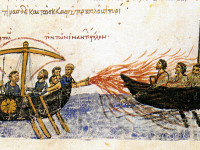The Greek fire was a firearm used in the 7th century by the Byzantine navy on its dromone ships.
The necessary technology was probably known in 677 by the Greek architect Kallinikos, who fled from the advancing Arabs from Heliopolis, now Lebanon, to Constantinople and this technique handed over to the Byzantine Empire.
Already during the siege of Constantinople by the Arabs from 674 to 678, this weapon was subsequently used and allowed the Byzantine navy to repel the enemy ships. Since then, she has been an integral part of naval tactics to combat enemy ships.
Application and impact:
The Greek fire can be thought of as similar to today's flame throwers. In the naval battles, the fire was fired in the direction of the enemy ships, so they caught fire. Due to the wood construction of the former ships, the fire spread quickly. In most cases, petroleum or asphalt was used as the combustible, and these liquids were barely extinguished as soon as they were ignited. In addition, if a burning ship fled in the direction of its own fleet, there was also the possibility that the fire would jump over to the other opposing ships. The disadvantage of the fire was, of course, in case of incorrect handling, bad weather or rough seas to set the own ship on fire.
Functionality:
The Greek fire was created by heating chemicals (mostly petroleum or asphalt, sometimes tree resin, sulfur or burned lime) in a kettle standing on a hearth. The liquid was then pressurized by a pump until a valve released it and transferred it to the nozzle. Then the liquid escaped from the nozzle and flew a few meters. The ignition was carried out by a flame which was placed under the exiting liquid. Although the range was only a few meters, but for the then naval command, this was quite sufficient.
The original Greek fire was used only by the Byzantine navy. Attempts by other navies to copy the system never reached the original. In addition, the technology was considered a state secret and the transfer was under the death penalty. With the downfall of the Byzantine Empire also the knowledge about the exact function and the recipe of the liquid was lost.
This post is also available in:
 Deutsch (German)
Deutsch (German)  Français (French)
Français (French)  Italiano (Italian)
Italiano (Italian)  简体中文 (Chinese (Simplified))
简体中文 (Chinese (Simplified))  Русский (Russian)
Русский (Russian)  Español (Spanish)
Español (Spanish)  العربية (Arabic)
العربية (Arabic)











